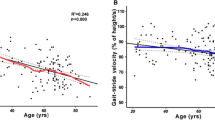Abstract
Walking is an everyday activity and contains variations from person to person, from one step to another step. The variation may occur due to the uniqueness of each gait cycle, personal parameters, such as age, walking speed, etc., and the existence of a gait abnormality. Understanding the normal variation depending on personal parameters helps medical experts to identify deviations from normal gait and engineers to design compatible orthotic and prosthetic products. In the present study, we aimed to obtain normal gait variations based on age, sex, height, weight, and walking speed. For this purpose, a large dataset of walking trials was used to model normal walking. An artificial neural network-based gait characterization model is proposed to show the relation between personal parameters and gait parameters. The neural network model simulates normal walking by considering the effect of personal parameters. The predicted behavior of gait parameters by artificial neural network model has a similarity with existing literature. The differences between experimental data and the neural network model were calculated. To determine how much deviation between predictions and experiments can be considered excessive, the distributions of differences for each gait parameter were obtained. The phases of walking in which excessive differences were intensified were determined. It was revealed that the artificial neural network-based gait characterization model exhibits the behavior of the normal gait parameters depending on the personal parameters.






Similar content being viewed by others
References
Danion F, Varraine E, Bonnard M, Pailhous J. Stride variability in human gait: The effect of stride frequency and stride length. Gait Posture. 2003. https://doi.org/10.1016/S0966-6362(03)00030-4.
Begg R, Sparrow W. Ageing effects on knee and ankle joint angles at key events and phases of the gait cycle. J Med Eng Technol. 2006. https://doi.org/10.1080/03091900500445353.
Judge JO, Ounpuu S, Davis RB III. Effects of age on the biomechanics and physiology of gait. Clin Geriatr Med. 1996. https://doi.org/10.1016/S0749-0690(18)30194-0.
Messier SP. Osteoarthritis of the knee and associated factors of age and obesity: effects on gait. Med Sci Sports Exerc. 1994;26(12):1446–52.
Røislien J, Skare Ø, Gustavsen M, Broch N, Rennie L, Opheim A. Simultaneous estimation of effects of gender, age and walking speed on kinematic gait data. Gait Posture. 2009. https://doi.org/10.1016/j.gaitpost.2009.07.002.
Kaufman KR, Hughes C, Morrey BF, Morrey M, An K. Gait characteristics of patients with knee osteoarthritis. J Biomech. 2001. https://doi.org/10.1016/S0021-9290(01)00036-7.
Filli L, Sutter T, Easthope CS, Killeen T, Meyer C, Reuter K, Lörincz L, Bolliger M, Weller M, Curt A, Straumann D, Linnebank M, Zörner B. Profiling walking dysfunction in multiple sclerosis: characterisation, classification and progression over time. Sci Rep. 2018. https://doi.org/10.1038/s41598-018-22676-0.
Hausdorff JM. Gait dynamics in Parkinson’s disease: common and distinct behavior among stride length, gait variability, and fractal-like scaling. Chaos. 2009;19(2): 026113. https://doi.org/10.1063/1.3147408.
Chu CR, Williams AA, Coyle CH, Bowers ME. Early diagnosis to enable early treatment of pre-osteoarthritis. Arthritis Res Ther. 2012;14(3):212. https://doi.org/10.1186/ar3845.
Balasubramanian CK, Neptune RR, Kautz SA. Variability in spatiotemporal step characteristics and its relationship to walking performance post-stroke. Gait Posture. 2009;29(3):408–14. https://doi.org/10.1016/j.gaitpost.2008.10.061.
Benedetti MG, Piperno R, Simoncini L, Bonato P, Tonini A, Giannini S. Gait abnormalities in minimally impaired multiple sclerosis patients. Mult Scler. 1999;5(5):363–8. https://doi.org/10.1177/135245859900500510.
Mills K, Hettinga BA, Pohl MB, Ferber R. Between-limb kinematic asymmetry during gait in unilateral and bilateral mild to moderate knee osteoarthritis. Arch Phys Med Rehabil. 2013;94(11):2241–7. https://doi.org/10.1016/j.apmr.2013.05.010.
Craig JJ, Bruetsch AP, Lynch SG, Huisinga JM. The relationship between trunk and foot acceleration variability during walking shows minor changes in persons with multiple sclerosis. Clin Biomech. 2017;49:16–21. https://doi.org/10.1016/j.clinbiomech.2017.07.011.
Zeni JA Jr, Higginson JS. Dynamic knee joint stiffness in subjects with a progressive increase in severity of knee osteoarthritis. Clin Biomech. 2009;24(4):366–71. https://doi.org/10.1016/j.clinbiomech.2009.01.005.
Hamill J, Moses M, Seay J. Lower extremity joint stiffness in runners with low back pain. Res Sports Med. 2009;17(4):260–73. https://doi.org/10.1080/15438620903352057.
Cimolin V, Galli M, Grugni G, Vismara L, Albertini G, Rigoldi C, Capodaglio P. Gait patterns in prader-willi and down syndrome patients. J Neuroeng Rehabil. 2010. https://doi.org/10.1186/1743-0003-7-28.
Galli M, Rigoldi C, Brunner R, Virji-Babul N, Giorgio A. Joint stiffness and gait pattern evaluation in children with Down syndrome. Gait Posture. 2008;28(3):502–6. https://doi.org/10.1016/j.gaitpost.2008.03.001.
Wang TM, Huang HP, Li JD, Hong SW, Lo WC, Lu TW. Leg and joint stiffness in children with spastic diplegic cerebral palsy during level walking. PLoS ONE. 2015;10(12): e0143967. https://doi.org/10.1371/journal.pone.0143967.
Kobayashi Y, Hida N, Nakajima K, Fujimoto M, Mochimaru M. AIST Gait Database 2019. 2019; https://unit.aist.go.jp/harc/ExPART/GDB2019.html
Moissenet F, Leboeuf F, Armand S. Lower limb sagittal gait kinematics can be predicted based on walking speed, gender, age and BMI. Sci Rep. 2019;9:9510. https://doi.org/10.1038/s41598-019-45397-4.
Mentiplay BF, Banky M, Clark RA, Kahn MB, Williams G. Lower limb angular velocity during walking at various speeds. Gait Posture. 2018;65:190–6. https://doi.org/10.1016/j.gaitpost.2018.06.162.
McGinley JL, Baker R, Wolfe R, Morris ME. The reliability of three-dimensional kinematic gait measurements: A systematic review. Gait Posture. 2009;29:360–9.
Acknowledgements
We would like to thank Dr. Hiroaki Hobara for his comments and the contributions on discussions.
Funding
The authors declare that no funds, grants, or other support were received during the preparation of this manuscript.
Author information
Authors and Affiliations
Contributions
GC carried out the concept of the study, performed calculations and obtained results. SK and YK contributed to discussions of the method, model, and results. SS contributed to discussions. GC wrote the manuscript, SK, YK and SS read and reviewed the manuscript. All authors read and approved the final manuscript.
Corresponding author
Ethics declarations
Competing interests
The authors declare that they have no competing interests.
Ethics approval
The study protocol of the publicly available AIST gait database was approved by the local ethical committee.
Informed consent
The written consent was obtained from all participants. (Source: https://unit.aist.go.jp/harc/ExPART/GDB2019.html).
Additional information
Publisher's Note
Springer Nature remains neutral with regard to jurisdictional claims in published maps and institutional affiliations.
Rights and permissions
About this article
Cite this article
Guzelbulut, C., Shimono, S., Yonekura, K. et al. Detection of gait variations by using artificial neural networks. Biomed. Eng. Lett. 12, 369–379 (2022). https://doi.org/10.1007/s13534-022-00230-2
Received:
Revised:
Accepted:
Published:
Issue Date:
DOI: https://doi.org/10.1007/s13534-022-00230-2




